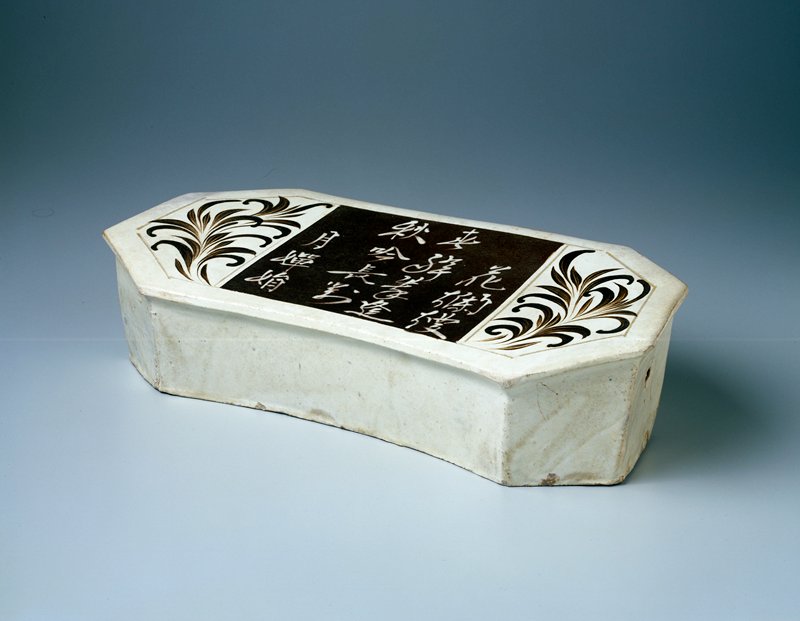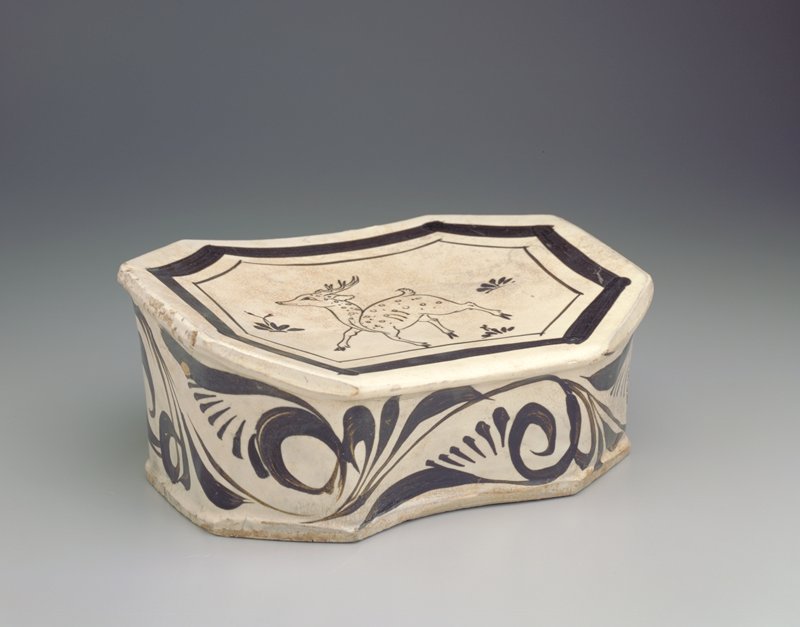Tiger Pillow

Tiger Pillow,
late 12th century
Stoneware with black and tan glaze over a white slip under a clear glaze
Introduction
Rippling black stripes on a rich orange coat. Gleaming white teeth and a focused gaze. A long tail tucked against a robust body. Most people would immediately recognize this animal as a tiger. But you might be surprised to learn that this ceramic beast about fifteen inches long was used as a pillow in 12th-century China. According to Chinese tradition, a pillow could give special qualities to the person who slept on it. Because the tiger has been a powerful symbol in China since ancient times, it made a good pillow.
KEY IDEA ONE
A Place to Rest Your Head
Many Americans today are accustomed to sleeping on soft, sometimes feathery pillows. But hard pillows and headrests, often made of wood, have been used in various cultures throughout the world in Africa, India, the Pacific Islands, and elsewhere. Ancient Chinese texts refer to pillows made of wood or bamboo, and such pillows were used in China into the 20th century.
Ceramic pillows began to appear in China in the Tang dynasty (618-906), and lots of them were produced in the Song dynasty (960-1279). Because they are so durable, they have lasted longer than other types of pillows made in those times. Modern scholars once believed that ceramic pillows were made only for use in tombs. The Chinese had a tradition of placing ceramic models of household objects in tombs, for use in the afterlife. But from written records and other evidence we now know that ceramic pillows had a practical purpose, too. However, it’s hard to tell which pillows were for everyday use and which were for tombs.

Headrest,
about 2635-2155 B.C.,
hardwood
This Egyptian headrest is over four thousand years old!

Democratic Republic of Congo,
Headrest,
19th century,
wood and copper
This headrest from the Luba culture protected its owner’s elaborate hairstyle.

Papua New Guinea,
Middle Sepik River,
Headrest,
date unknown, wood, cane, and fiber
Animal figures decorate this large headrest from Papua New Guinea.
KEY IDEA TWO
The Power of Pillows
Pillows with magical powers appear in many Chinese folktales and superstitions. There is a tale about the adventures of a man who could climb inside his pillow and be magically transported to other places. One of the legendary Taoist Immortals is said to have used a pile of three books of Taoist teachings as his pillow, to inspire pure and elegant dreams. A folk medicine recipe called for filling a wooden pillow with herbs and other substances. After a year of sleeping on the pillow, the recipe claimed, white hair will turn black, new teeth replace those fallen out, and hearing and sight will grow clear.
The scholar Kao Lien, writing in 1591, recommended porcelain pillows because they brighten the eyes and benefit the pupils. When night comes, he claimed, one can read finely printed books using such a pillow. He also noted that porcelain pillows offered soothing coolness during hot weather. Although this pillow is stoneware rather than fine porcelain, it too would have had that cool quality.

Octagonal Pillow,
12th-early 13th century,
stoneware with brown and white slip
A poem or saying inscribed on a pillow soothed the owner.

Democratic Republic of Congo,
Headrest,
about 1880,
wood, beads, and string
African headrests are powerful objects. The figures on this Luba headrest are female ancestors who literally and figuratively support the chief.
KEY IDEA THREE
Signs and Symbols
The butterfly and flower designs on the top of this pillow may have had a symbolic meaning, or perhaps they simply suggested the sweet dreams of peaceful sleep. The tiger, though, has a clear history of symbolism.
The tiger was an important symbol in the ancient Chinese philosophy of Taoism (DOW-ism). Taoism explains the world in terms of two opposite forces: yin (from the ancient Chinese word for shady) and yang (from the word for bright). Yin includes darkness, water, wind, and the earth. Yang includes light, fire, rain, and the heavens. Yin is passive, while yang is active. According to this philosophy, everything in the universe results from the interaction of yin and yang. The dragon, a mythical animal thought to rule the heavens, stands for yang. The tiger, considered the mightiest animal on earth, stands for yin.
Tigers and dragons were popular subjects for paintings at the time this pillow was made. As a symbol for yin (darkness and inactivity and the west, where the sun sets), the tiger may have seemed an especially good form for a pillow. A tiger pillow scared off evil influences as a person slept. Children’s pillows often not ceramic but made of cotton or silk stuffed with grain husks frequently took the form of a tiger, to protect the child from demons that cause nightmares.

Tiger,
about 1560,
ink on paper
Tigers were popular Daoist images, used on decorative folding screens and scroll paintings.

Pillow,
Song dynasty (960-1279),
stoneware with painted decoration on white slip under a clear glaze
Many animals hold symbolic meaning. The deer decorating this pillow is an emblem of good luck and longevity.A tea caddy held expensive imported tea. A tiny key original to the set locks this little box.

Northern Song dynasty (960-1127),
stoneware with black and white slips and sgraffito decoration under transparent glaze
The peony, a common design on Chinese pillows, symbolizes wealth, spring, and feminine beauty.
Related activities
Pillow Pals
What qualities do you associate with tigers? What animal would help you sleep? What animal would be the most comforting? Why? Draw or sculpt a pillow in the shape of your favorite animal.
A Hard Night’s Sleep
Many people are surprised to learn that pillows are sometimes made of hard materials instead of the soft ones common in the United States. How might it feel to sleep on a ceramic pillow or a wood pillow? How do you think you would sleep? What kind of pillow do you prefer?
Good Night and Good Luck
Ceramic pillows usually had popular songs, Confucian sayings, or poems inscribed on them. What would you like inscribed on your pillow? Write a short poem wishing yourself good
The Dream Diaries
Sleep and dreams can seem mysterious. What do you think happens when you sleep? What do you think causes dreams? Keep a dream journal for a week. What kinds of dreams did you have? What was your favorite dream? Did things you did during the day affect your dreams?
